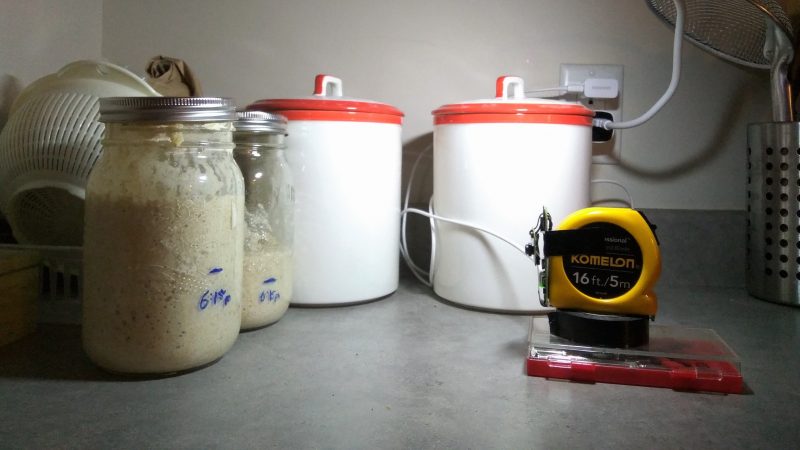Those of you who’ve never had a real sourdough have never had real bread. Good food fights back a little when you eat it, and a proper sourdough, with its crispy crust and tangy center, certainly fits the bill. Sourdough aficionados, your humble writer included, all have recipes that we pretend are ancient family secrets while in reality we’re all just guessing. Sourdough is partly science, partly art, but mostly delicious black magic.
In an effort to demystify his sourdough process, [Justin Lam] has gone digital with this image processing sourdough starter monitor. Sourdough breads are leavened not by the addition of brewers yeast (Saccharomyces cerevisiae), but by the inclusion of a starter, a vibrant ecosystem of wild yeasts that is carefully nurtured, sometimes for years. Like any other living thing, it needs to be fed, a task that should happen at the point of maximum fermentation. Rather than guess when this might be, [Justin] used a Raspberry Pi Zero and PiCam to capture a time-lapse video of the starter as the beasties within give off their CO₂, thus expanding it up inside its container. A little Python does the work of thresholding and finding the top of the starter as it rises, allowing [Justin] to plot height of the starter over time. He found that peak height, and therefore peak fermentation, occurs about six hours after feeding. He has used his data to better inform his feeding schedule and to learn how best to revive neglected starters.
Surprisingly, this isn’t the first time we’ve discussed sourdough here. It seems that someone uses Git for iterative sourdough recipe development, and we once featured a foundry made from a pyrolyzed loaf of sourdough.
[wpvideo 1jrRbYB2]
















I’d guess that a large part of the power usage is for the lamp, which could be changing what is being measured. It might be an idea to use a GPIO pin on the RPi with a SSR to turn the light on 1-5 seconds before the image is taken and off 1-2 second after the image is taken. So that the lighting for the measurement has minimal effect on the yeast for the remainder of the 300 seconds between each image. It also means that you could use a slightly more powerful light source for sharper images.
That would be my suggestion, take it or leave it – great project though.
Is this stuff sensitive to light?
Instead of a camera with a flash, you could reverse it and take a video with a webcam and only turn the light on for a few frames every now and then.
How does this stuff react to temperature?
Can you directly measure the volume / rate of CO2 released?
Wine makers use such a bent tube with a bit of liquid in it and they count the bubbles through the liquid for this.
Lots of room for some experimentation.
Sourdough is its own ecosystem. Light is no problem at all. I’m baking with sourdough for 10 years now. Temperature, hydration and type of flour is what controls it entirely. Lower temp. = more acetic acid, higher = more lactic acid. Acetic acid is what gives the main tang to the sourdough.
Thing is, after a few years you know what your starter needs at which room temperature. When it has risen highest it’s fully done most of the times, totally independent from the type of sourdough. That’s why the attempt in the video works.
This correlates with my similar length of experience. You can read a culture by its smell too, but it is as tricky are doing the same with tea or wine, for the same biochemical reasons.
The true and only purpose of sourdough bread is to act as a vessel or utensil for a charcoal grilled sausage, preferably swine, covered in some mustard. A slice can easily be reused several times without becoming soggy and weird. After a sausage session, the bread is easily disposed of in any variety of ways. I generally toss it in the trash because it is rather unpalatable.
Pfft you’re a utensil for sausage
Yeah Justin!
Fascinating. I wish I had such great ideas a while back when I decided to get started with sourdough starters. Turns out my black thumb carries over to fungus as well. Maybe if I build a robot I can take my incompetence out of the equation! That would be great.